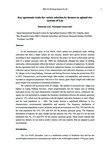In the mountainous areas of Lao P.D.R, where upland rice production under shifting cultivation has been a major system for rice security, farmers have grown diverse varieties according to their indigenous knowledge. However, the policy for forest conservation and the shift to a market economy since the 1990s has dramatically changed the nature of shifting cultivation, which potentially affects the farmers’ selection of varieties of upland rice. To identify the key agronomic traits for variety selection by upland rice farmers, we conducted a germplasm collection and an interview survey of rice characteristics and cultivation frequency in a total of 26 villages in the Luang Prabang, Vientiane and Sekong Provinces during the period from 2014 to 2015. Characteristics, such as plant height, tiller number, soil adaptability, and maturity, were recorded as categorical parameters with two to five classes; grain shape (length and width) and grain weight were measured as continuous parameters. We collected 244 accessions from 26 villages. The number of accessions per village was highest in Luang Prabang Province, which proportionately has the largest area of shifting cultivation in Lao. For each characteristic evaluated with the interview survey, a Pearson's chisquare test was performed to compare the frequency distribution between the primary genotype group (n =27), which were the genotypes with the highest cultivation frequency in each village, and the total population (n = 244). The results showed a significant difference in two characteristics: environmental adaptability and maturity. The frequency distribution of environmental adaptability to poor, moderate and good environments was 29%, 55% and 24% for the total population but 15%, 22% and 63% for the primary genotype group. The frequency distribution of maturity for early, middle and late maturity was 19%, 30% and 51% for the total population but 7%, 11% and 82% for the primary genotype group. These results indicate that upland rice farmers in Lao tend to prefer varieties with late maturity that are adapted to good environments.

